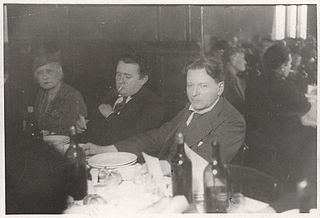
George Enescu, known in France as Georges Enesco, was a Romanian composer, violinist, conductor, and teacher and is regarded as one of the greatest musicians in Romanian history.
Paul Constantinescu was a Romanian composer. Two of his main influences are Romanian folk music and Byzantine chant, both of which he used in his teaching. One of his students was composer Margareta Xenopol.

Symphony No. 1, Op. 13, in E♭ by the Romanian composer George Enescu reflects the composer's training in both Vienna and Paris. In the former location he studied the Brahmsian tradition with Robert Fuchs, and in the latter the French tradition with Jules Massenet and Gabriel Fauré.
Valentin Gheorghiu was a Romanian classical pianist and composer. He is regarded as a leading Romanian pianist of the twentieth century, focused on both piano concertos of the Romantic period and chamber music. He won the prize for the best performance of Enescu's Violin Sonata No. 3 at the first George Enescu International Competition in 1958, with his brother Ștefan as the violinist. He made recordings with international orchestras and conductors.

The two Romanian Rhapsodies, Op. 11, for orchestra, are George Enescu's best-known compositions. They were written in 1901, and first performed together in 1903. The two rhapsodies, and particularly the first, have long held a permanent place in the repertory of every major orchestra. They employ elements of lăutărească music, vivid Romanian rhythms, and an air of spontaneity. They exhibit exotic modal coloring, with some scales having 'mobile' thirds, sixths or sevenths, creating a shifting major/minor atmosphere, one of the characteristics of Romanian music. They also incorporate some material found in the later drafts of Enescu's Poème roumaine, Op. 1.

The Octet for strings in C major, Op. 7, is an octet composition for string instruments by the Romanian composer George Enescu, completed in 1900. Together with the Octet in F major, Op. 17 (1849) by Niels Gade, it is regarded as amongst the most notable successors to Felix Mendelssohn's celebrated Octet, Op. 20.

The Sonata No. 3 in A minor "dans le caractère populaire roumain" for violin and piano, Op. 25, is a chamber music composition written in 1926 by the Romanian composer George Enescu. The score, published in 1933, is dedicated to the memory of the violinist Franz Kneisel. It is one of the composer's most popular and at the same time most critically respected works.

Symphony No. 2, Op. 17, in A major by the Romanian composer George Enescu was written in 1912–14. A performance lasts about 55 minutes.

The Symphony No. 3, Op. 21, in C major is a large-scale orchestral-vocal composition by the Romanian composer George Enescu. While it was first written in 1916–18. the composer revised it numerous times over the following decades.

The Symphony No. 4 in E minor is an orchestral composition by the Romanian composer George Enescu, left incomplete at the composer's death, but finished in 1996 by Pascal Bentoiu.

The Symphony No. 5 in D major is a large-scale composition for orchestra, tenor soloist, and female choir by the Romanian composer George Enescu, using a text by the Romanian poet Mihai Eminescu. Drafted in 1941 and partially orchestrated at some later date, the symphony was left unfinished at Enescu's death, but has been completed posthumously, first partially by Cornel Țăranu in 1970–72 and 1990, then in complete form by Pascal Bentoiu in 1995.

Piano Quartet No. 2 in D minor, Op. 30, is a chamber-music composition by the Romanian composer George Enescu, written in 1943–44.

The Piano Quartet No. 1 in D major, Op. 16, is a chamber music composition by the Romanian composer George Enescu, written in 1909 and first performed in Paris the same year.

The Piano Quintet in A minor, Op. 29, is a chamber music work by the Romanian composer George Enescu, written in 1940.

The Sonata No. 3 for Piano in D major, Op. 24, No. 3, is a piano sonata by the Romanian composer George Enescu, written between 1933 and 1935.

The String Quartet No. 2 in G major, Op. 22, No. 2, is a chamber music work by the Romanian composer George Enescu, composed mainly between 1950 and 1951, though it has a lengthy pre-history and received a number of revisions in 1952 and possibly early 1953. The score is dedicated to the American pianist, composer, and arts patron, Elizabeth Sprague Coolidge. A performance of it lasts about 25 minutes.

The Sonata No. 1 for Piano in F-sharp minor, Op. 24, No. 1, is a piano sonata by the Romanian composer George Enescu, completed in 1924.

The Sonata No. 2 for violin and piano in F minor, Op. 6, is the second violin sonata by the Romanian composer George Enescu, completed in 1899.

The Decet for winds in D major, Op. 14, is a chamber music work by the Romanian composer George Enescu, written in 1906 and first performed in Paris the same year. A performance lasts about 23 minutes.

The String Quartet No. 1 in E-flat major, Op. 22, No. 1, is a chamber music work by the Romanian violinist and composer George Enescu, composed between 1916 and 1920. A performance of it lasts about 45 minutes.








